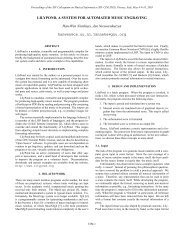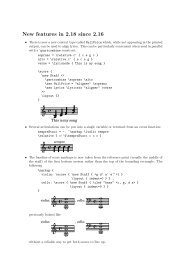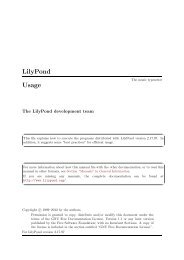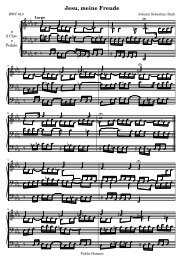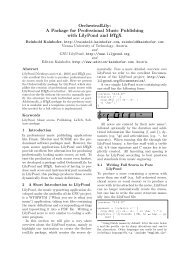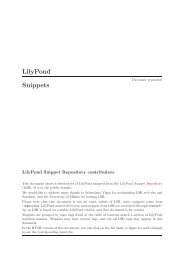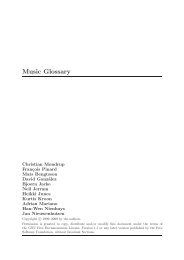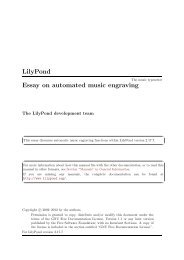You also want an ePaper? Increase the reach of your titles
YUMPU automatically turns print PDFs into web optimized ePapers that Google loves.
Chapter 4: Tweaking output 86<br />
This looks a good bet to change the heaviness. It tells us that the value of thickness is a<br />
simple number, that the default value is 1.2, and that the units are in another property called<br />
line-thickness.<br />
As we said earlier, there are few to no explanations in the IR, but we already have enough<br />
information to try changing the slur thickness. We see that the name of the layout object is<br />
Slur, that the name of the property to change is thickness and that the new value should be<br />
a number somewhat larger than 1.2 if we are to make slurs thicker.<br />
We can now construct the \override command by simply substituting the values we have<br />
found for the names, omitting the context. Let’s use a very large value for the thickness at first,<br />
so we can be sure the command is working. We get:<br />
\override Slur #'thickness = #5.0<br />
Don’t forget the #' preceding the property name and a # preceding the new value!<br />
The final question is, ‘Where should this command be placed?’ While you are unsure and<br />
learning, the best answer is, ‘Within the music, before the first slur and close to it.’ Let’s do<br />
that:<br />
{<br />
}<br />
\time 6/8<br />
{<br />
% Increase thickness of all following slurs from 1.2 to 5.0<br />
\override Slur #'thickness = #5.0<br />
r4 b8 b[( g]) g |<br />
g[( e]) e d[( f]) a |<br />
a g<br />
}<br />
\addlyrics {<br />
The man who feels love's sweet e -- mo -- tion<br />
}<br />
�<br />
8 6<br />
�<br />
�<br />
�<br />
�<br />
�<br />
�<br />
�<br />
�<br />
�<br />
�<br />
�<br />
�<br />
�<br />
The man who feels love's sweet e motion<br />
and we see that the slur is indeed heavier.<br />
So this is the basic way of constructing \override commands. There are a few more complications<br />
that we shall meet in later sections, but you now know all the essentials required to<br />
make up your own – but you will still need some practice. This is provided in the examples<br />
which follow.<br />
Finding the context<br />
But first, what if we had needed to specify the Context? What should it be? We could guess<br />
that slurs are in the Voice context, as they are clearly closely associated with individual lines of<br />
music, but can we be sure? To find out, go back to the top of the IR page describing the Slur,<br />
where it says ‘Slur objects are created by: Slur engraver’. So slurs will be created in whichever<br />
context the Slur_engraver is in. Follow the link to the Slur_engraver page. At the very<br />
bottom it tells us that Slur_engraver is part of five Voice contexts, including the standard<br />
voice context, Voice, so our guess was correct. And because Voice is one of the lowest level<br />
contexts which is implied unambiguously by the fact that we are entering notes, we can omit it<br />
in this location.<br />
�<br />
�<br />
�<br />
�<br />
�<br />
�



